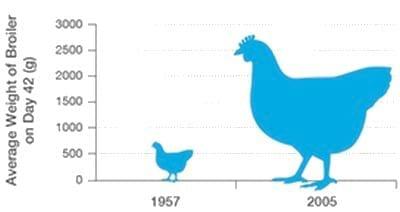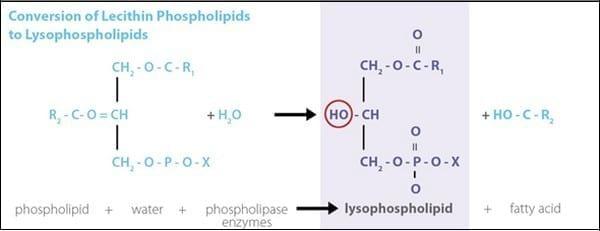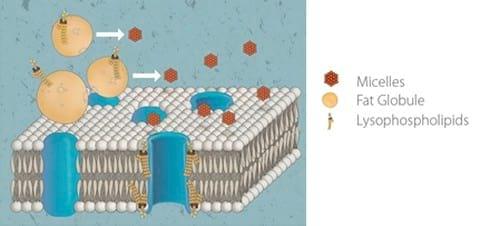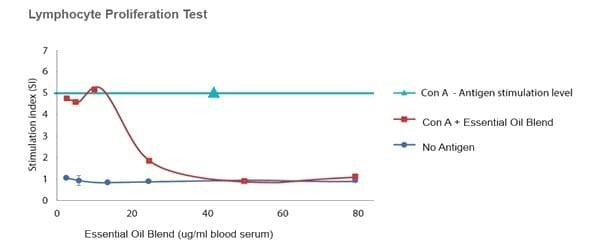Nutrient Absorption - Reframing the possible
Published: March 14, 2016
By: Dr. Swamy Haladi, DVM., PhD, Regional Director, Devenish Nutrition Limited, Belfast, United Kingdom.
Optimisation of technical and economic performance in modern broiler production is a complex matter which increasingly requires a revaluation and reframing of what is perceived to be possible through nutrition and management.
Reframing to deliver on genetic potential and global demands
Few would have thought in the 1950’s that we would see a fourfold increase in weight of commercial broilers in just 50 years. However, this has been realised (Figure 1). Rates of improvement in FCR are reported amongst most genetics companies to have been be in the order of 2 points per annum for the past 40 years and it is predicted that this trend will continue. If this rate of change is sustained for the coming decades then we must radically reimagine and reframe our expectations and targets with regard to the nutritional provision of these animals.
Figure 1:

With regard to the global supply and demand of high quality protein it has been forecast by the OECD, FAO and others that there will be a 40-50% increase in annual global demand for poultry meat over the period from 2015 – 2030. This equates to over 40 million tonnes of additional poultry meat production annually on a global scale with markets in Asia and Africa seeing growths of nearer 60%.
A key challenge as an industry is how we deliver on the improving genetic potential of poultry while working with often limited and variable feed raw materials under a variety of environmental and management constraints. Growing affluence in many markets is also increasing the price competition between human food and animal feed for cereal and vegetable protein sources. Poultry producers must be ever more precise in the formulation and utilisation of their given feed resources and active in the re-examination of the use of some feed materials and by products which previously were not considered economically valuable or technically justifiable.
Existing Nutritional strategies:
Undoubtedly there have been significant advances in recent decades in the improved digestion and utilisation of feed nutrients. The 1980 and 1990’s saw the arrival of non-starch polysaccharide (NSP) enzymes which have continuously improved in efficacy over time to become commonplace in most cereal based nutritional programs. Phytase enzymes have further improved nutrient utilisation beyond that of its central role in the liberation of phytate bound phosphorous. However, research has increasingly focused on the role of multi-enzyme solutions to reflect the diversity of raw materials present in many markets particularly the rapidly growing Asian and African markets. Here the potential contribution of protease, cellulase and amylase enzymes can be significant in maximising the releases of nutrients especially in high fibre/more lignified raw materials.
In addition to the role of NSP enzymes in reducing viscosity in the gut, dietary emulsifiers (Lecithin derivatives as well as synthetics) have resulted in improvement in the emulsification of fats in the diets, improving digestion and absorption. The challenge now is how to further advance the digestion and absorption of nutrients beyond the high levels (>90% utilization) achieved by the aforementioned technologies.
Reframing the possible:
In order to imagine a step change improvement in nutrient digestion and absorption one must consider the challenge at the following levels:
- Gut tissue integrity and absorptive surface permeability
- The inflammatory status at the gut lumen level
- The nutrigenomic interactions at play in the animal
When we consider ways to positively influence the above aspects, we invariably find that combinations of molecules can results in superior benefits over and above that of singular feed additives. As will be explored in the coming discussion significant advances in nutrient digestion and absorption can be achieved in addition to the benefits brought about by exacting diet formulation and use of in feed enzymes.
The role of Lysophospholipids
Lysophospholipids (LPL) are bio active molecules derived from the enzymatic hydrolysis of Lecithin phospholipids (Figure 2). These Lecithin phospholipids are typically found in high oil content crops such as soya bean, rapeseed and sunflower and are remaining following the processing of these crops into their protein, fibre and oil fractions.
Figure 2.

LPL’s have been known for some time to be potent emulsifiers as their reactive side chain works to form stable oil in water emulsions through the production of small micelles aiding fat digestion and absorption.
In addition to this emulsification impact, new enhanced synthesis technology allows for careful selection of key LPL’s which have highly positive impacts on the permeability of the gut epithelium. This impact is brought about by the structural similarity of the phospholipid bi layer in the epithelial cells to that of the LPL’s thereby allowing their passive movement into and out of the cell membrane and facilitating great nutrient access to the active and passive transporters on the absorptive surface (Figure 3). In addition to physical impacts on digestion and absorption, gene expression studies are discovering the role of certain LPL’s in up regulation of protein synthesis pathways and down regulation of inflammatory responses.
Figure 3.

The role of Essential Oils.
Over the past decade scientific research has attempted to ascertain the potential of plant derived Essential Oils to contribute to animal health and performance. Initial research focused primarily on alternatives to antibiotics. More recently the development of molecular technologies such as real time PCR and Nutrigenomic evaluations have uncovered the role of Essential Oils in positively influencing endogenous digestive sections (HCL, pancreatic Lipase and mucous) along with the management of the inflammatory response in the animal. Both of the above functions result in improved digestion and absorption due to a lower level of subclinical inflammation in the gut lining.
A recent study explored the anti-inflammatory impact of selected Essential Oils in monogastric blood serum. The Lymphocyte Proliferation Test (LPT) measured the proliferation of immune response cells in reaction to the presence of an irritant/antigen (CON A). It is clear that the presence of the Essential Oils in the blood serum at very low levels had the effect of down regulating the inflammatory response, as seen by a reduction in the stimulation index (Figure 4). As energy expenditure associated with the activities of the intestine comprise 20-25% of daily energy intake in broilers, a reduction in inflammation in this tissue can contribute to significant energy savings in diet formulation.
Figure 4:

Quantifying the benefits –Reframing the possible
Based on the knowledge gained relating to the impact of Lysophopholipids (LPL) and Essential Oils, Devenish brings to the market innovative technology to improve digestion and absorption of nutrients, DiNAMIC. Commercial application of DiNAMIC across a variety of market and dietary conditions has repeatedly demonstrated the scope to reformulate diets to a lower nutrient density while maintaining and improving broiler feed efficiency and EPEF.
A trial was conducted in 2013 to evaluate the digestibility impacts of this unique, dual actives combination of LPL and Essential Oils. The trial compared the ileal digestibility of nutrients in Ross 308 males fed control diets, with breed recommended nutrient contents, against diets containing DiNAMIC with a reduction in AME of 95.6 kcal/kg. Diets were Maize/Wheat/Soya based and contained sunflower and full fat soya along with a palm oil based fat blend. All diets contained commercial NSP and phytase enzymes.
The results, as presented in Table 1, clearly demonstrates the highly significant positive impact of the combination of the dual actives of LPL and Essential Oils in improved digestibility in the total diet.
Table 1:

Values without a common superscript differ significantly (p<0.05)
The above data combined with a wealth of scientific and feed trial performance data provides the basis of a generous nutrient matrix allowance for this LPL + Essential Oil combination. This nutrient allowance is in addition to the allowance provided to feed enzymes in the formulation, thereby significantly reducing the cost of production for the poultry producer.
Conclusions
The rapid growth in both genetic potential and protein demands pose both great opportunity and challenges for nutritionists and poultry producers globally. We must continuously look to complement the established norms of feed additives with novel and imaginative new solutions. In this way we reframe the concept of what is possible and create a new, higher ambition for our animals and production systems.
Devenish is at the forefront in research and product development in going Beyond Nutrition to realise the potential of both our customer’s animals and their business.
Please contact us to see if DiNAMIC can improve the performance of your broilers.
Related topics:
Authors:
Trouw Nutrition
Recommend
Comment
Share

Would you like to discuss another topic? Create a new post to engage with experts in the community.








.jpg&w=3840&q=75)